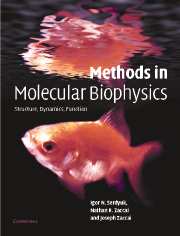Book contents
- Frontmatter
- Contents
- Foreword by D. M. Engelman
- Foreword by Pierre Joliot
- Preface
- Introduction: Molecular biophysics at the beginning of the twenty-first century: from ensemble measurements to single-molecule detection
- Part A Biological macromolecules and physical tools
- Part B Mass spectrometry
- Part C Thermodynamics
- Part D Hydrodynamics
- Part E Optical spectroscopy
- Chapter E1 Visible and IR absorption spectroscopy
- Chapter E2 Two-dimensional IR spectroscopy
- Chapter E3 Raman scattering spectroscopy
- Chapter E4 Optical activity
- Part F Optical microscopy
- Part G X-ray and neutron diffraction
- Part H Electron diffraction
- Part I Molecular dynamics
- Part J Nuclear magnetic resonance
- References
- Index of eminent scientists
- Subject Index
- References
Chapter E2 - Two-dimensional IR spectroscopy
from Part E - Optical spectroscopy
Published online by Cambridge University Press: 05 November 2012
- Frontmatter
- Contents
- Foreword by D. M. Engelman
- Foreword by Pierre Joliot
- Preface
- Introduction: Molecular biophysics at the beginning of the twenty-first century: from ensemble measurements to single-molecule detection
- Part A Biological macromolecules and physical tools
- Part B Mass spectrometry
- Part C Thermodynamics
- Part D Hydrodynamics
- Part E Optical spectroscopy
- Chapter E1 Visible and IR absorption spectroscopy
- Chapter E2 Two-dimensional IR spectroscopy
- Chapter E3 Raman scattering spectroscopy
- Chapter E4 Optical activity
- Part F Optical microscopy
- Part G X-ray and neutron diffraction
- Part H Electron diffraction
- Part I Molecular dynamics
- Part J Nuclear magnetic resonance
- References
- Index of eminent scientists
- Subject Index
- References
Summary
The present chapter is included in Part E with the other optical spectroscopy methods; however, the development of two-dimensional IR (2D-IR) spectroscopy is strongly based on two-dimensional NMR, and it is easier to understand after reading the relevant sections in Part J, which the reader is strongly encouraged to do first.
Historical review and introduction to biological problems
1950
O. Hann proposed coherent spectroscopy – the use of radiation fields with well-defined phase properties – to extract information about atoms and molecules. The ‘spin echo’ experiment in nuclear magnetic resonance was the first demonstration of the possibilities of coherent spectroscopy.
1957
R. P. Feynman, F. L. Vernon Jr. and R. W. Hellwarth published a landmark paper pointing out that if coherent light fields were ever created, it would be possible to use these same methods on optical transitions. The invention of the laser in 1960 was followed quickly by a demonstration of the ‘photon echo’ – the optical version of the ‘spin echo’.
1998
R. M. Hochstrasser and collaborators proposed 2D IR spectroscopy, in analogy with two-dimensional NMR, for the determination of time-evolving structures. The spins associated with the different nuclei in NMR are replaced in the IR experiments by a network of vibrational modes whose coupling can be used to determine molecular structure and dynamics. Structures of dipeptides, tripeptides and pentapeptides were determined by 2D IR spectroscopy. The most exciting aspect of 2D IR spectroscopy, however, is the combination of its sensitivity to structure with time resolution.
- Type
- Chapter
- Information
- Methods in Molecular BiophysicsStructure, Dynamics, Function, pp. 562 - 572Publisher: Cambridge University PressPrint publication year: 2007



